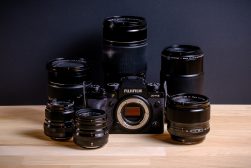
Fujifilm X-Pro 3 Camera Review
The Fujifilm X-Pro 3 is sharp, stylish & willing to break the rules of digital photography. Read this in-depth review for everything you need to know.
It’s no secret that I’m a huge fan of the Fujifilm X Series of cameras and of course their extensive lens range.
There’s a very special kind of magic that dictates that every best Fujifilm camera has initiative, design excellence, and complete usability.
It’s those core elements that make people fall in love with the system and work with Fujifilm gear at both an enthusiast and pro level.
Despite my love of all things Fujifilm, I have not always been a fan of the X-Pro series. I personally stuck to the Fujifilm X-T1, X-T2 and now my workhorse in the Fujifilm X-T3.
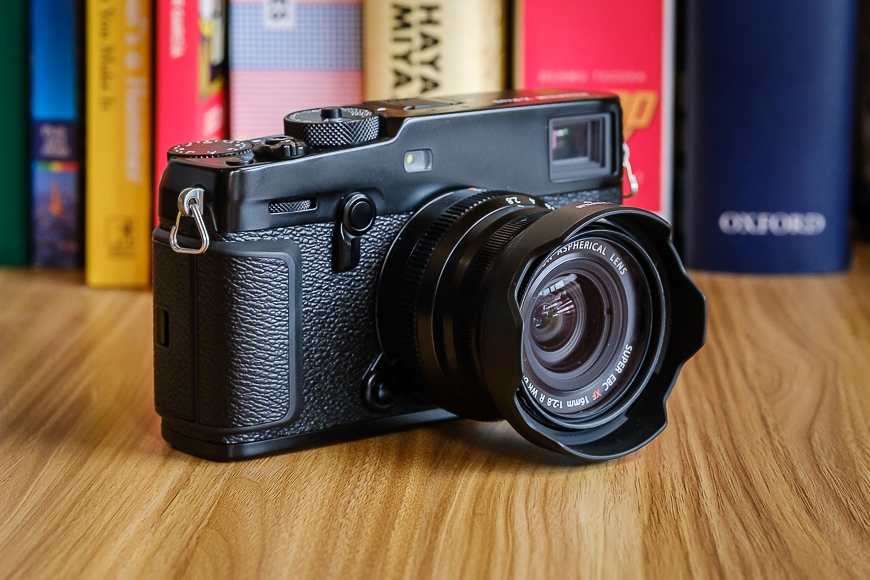
Exceptional performance, titanium construction and a unique design make the X-Pro 3 stand out from the crowd.
Many Fuji users go one way of the other with their choice of flagship Fujifilm camera. For me, I passed on the rangefinder-style camera with its hybrid viewfinder.
Then along came the Fujifilm X-Pro 3, announced in late 2019 in not one but three premium colours (though coatings would be a better term to use).
Suddenly, the X-Pro series had my attention.
The X-Pro 3 boasted most of what the Fujifilm X-T3 had to offer plus some nice surprises for stills photographers wanting exceptional images.
However, it’s fair to say that this camera was met with mixed reviews as it dared to introduce changes into a market that believed it had some steadfast rules. It was considered controversial for various reasons and that is what I love about this camera.
The Fujifilm X-Pro 3 dares to challenge convention both aesthetically and technically and the end result is a truly exceptional piece of kit.
Whilst originally promoted as a true street photography camera, the new Fuji is a powerhouse that could be used in any setting and for any genre of photography.
Fujifilm being Fujifilm, they haven’t taken this opportunity lightly as they seem to be on a winning streak at the moment.
Not long after the announcement of the X-Pro 3, Fuji announced the Fujifilm X-T200, then most recently they announced the much anticipated Fujifilm X100V. In a matter of weeks, they will reveal the new Fujifilm X-T4.
Don’t fret, we will cover all of those new releases in the future right here on Shotkit.com. What a time to be a Fujifilm X Series lover!
Despite all the noise created around the new camera releases, this new Fujifilm camera keeps calling out to me to pay a closer look. That’s exactly what we’re going to do over the course of this article.
We’re going to explore all the technical specifications, the controversies, the surprises and, of course, the real world shooting experience of this camera.
Let’s get stuck in to see if this is one of the best small cameras of 2024!
Fujifilm X-Pro 3 Specs
- Incredibly stylish camera with retro design
- Focus on driving the joy of photography
- Exceptional performance
- Fantastic image quality
- Film simulations
- Sub-monitor with film stock images
- Takes time to adjust to the hidden LCD
- Premium price for an additional coating
- I don’t own one yet…!
- 26.3Mp CMOS Sensor
- X-Processor 4
- 11 Frames Per Second burst mode
- Dimensions: (W) 140.5mm × (H) 82.8mm × (D) 46.1mm / (W) 5.5in × (H) 3.3in × (D) 1.8in
- Weight: Approx. 497g / 17.5oz (including battery and SD memory card)
- Weather-Sealed
- 17 Film Simulation Modes
- 4K Video @ 29P
- Magnesium body with titanium top and bottom plates
- Enhanced HDR mode
- Duratech coating to provide a scratch-resistant surface (not available on black version)
- Hidden flip-down LCD touch screen
Build & Appearance
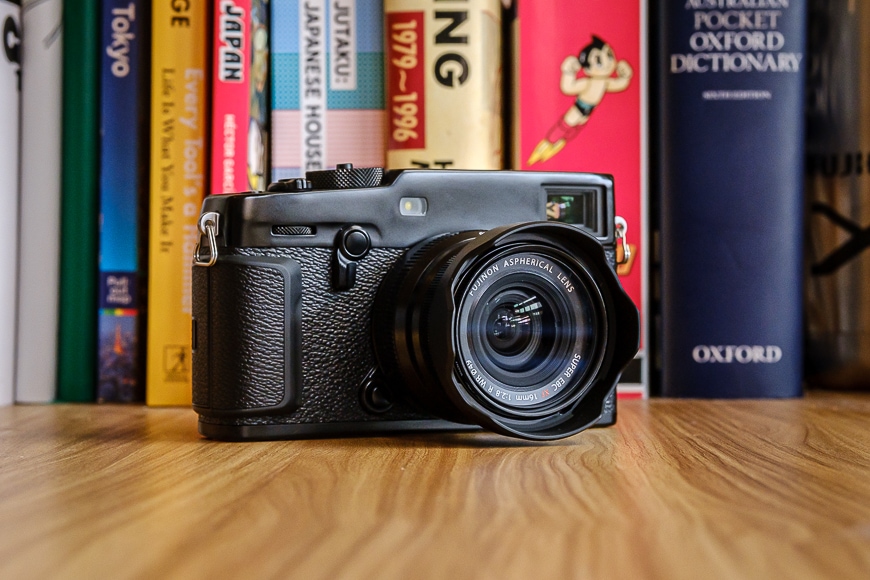
True to its roots, the Fujifilm X-Pro 3 has a stylish and retro design.
True to the Fujifilm design style, the new X-Pro 3 has a beautiful retro design that is reminiscent of rangefinder-style cameras from decades past.
At first, the body appears very block-like, but after closer examination, you come to realise that every inch has stylish design considerations.
(…so much so, in fact, that this camera draws people’s attention and admiration when you’re walking around with it in hand.)
The X-Pro 3 is built up from a magnesium frame making it incredibly durable while being mindful of the overall weight of the camera. The top and base plate of the body is made from precision-machined titanium and then a final coating is applied.
It first comes in a standard black finish where the entire body, including all dials and buttons, are also black. This is the stealthiest version for those of you that like to shoot street photography like a ninja.
There are two further colour variations: Dura Black and Dura silver. These two variations are coated with a product known as Duratech(TM) which is owned by the Citizen Watch Company – another precision engineering manufacturer.
Duratech is a coating that is applied to the finished Titanium on the exterior surfaces of the camera body. Dura Black is a slightly tinted coating on the raw Titanium and Dura Silver is a clear Duratech coating on the raw Titanium.
This has been a big selling point for Fujifilm as they claim that the Duratech coating will prevent the Titanium body from being scratched without serious effort.
This is a claim that I fully believe, having seen a representative from Fujifilm scratch at the surface with a box cutter to no avail. The surface remained scratch-free just as they promised.
The rest of the body is wrapped in a synthetic skin with a leather-like look and feel.
The Fuji feels incredibly solid in the hand and has a perfect amount of weight to it. Surprisingly, the X-Pro 3 weighs in at 497gm and can easily be handheld for a considerable period of time. In comparison, the Fujifilm X-T3 weighs a little more at 539gm.
Due to the growing range of Fujifilm X Series lenses available, the X-Pro 3 can be paired with any lens to meet any purpose. There are 21 prime lenses, 12 zoom lenses and a couple of cine lenses.
Given the early marketing suggesting this is a true street photography camera, you can comfortably get away with one of the smaller Fuji prime lenses. A lens such as the XF 16mm f/2.8 or the XF 23mm f/2 adds to the retro look and quality of this camera.
A final note regarding build quality is that the Fuji X-Pro 3 is weather and dust resistant. When paired with one of the many Fuji lenses that are weather-resistant, you have a completely street-ready kit regardless of the conditions.
-
Hidden LCD
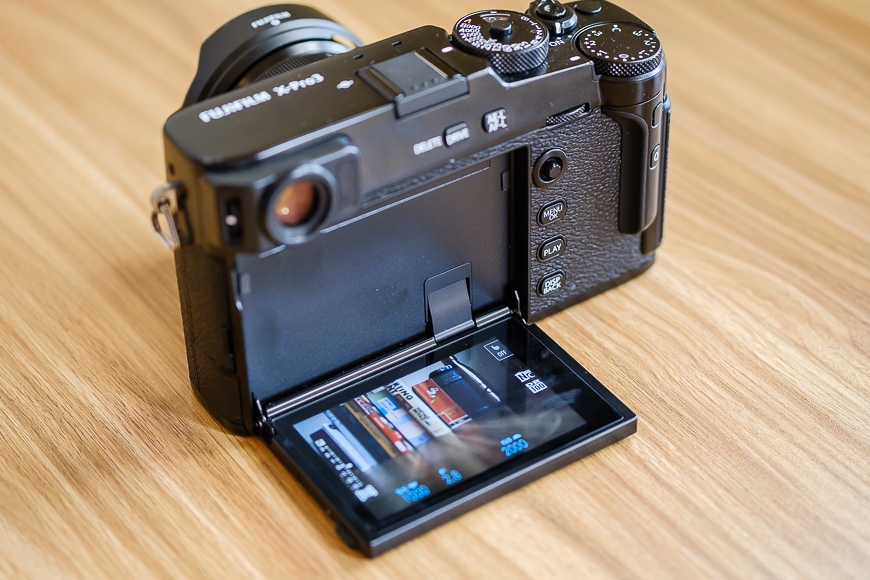
The controversial hidden rear LCD screen on the Fujifilm X-Pro 3.
There is a feature of the X-Pro 3 that appeared to have broken the photography-related internet for at least one news cycle…
It caused quite the controversy in photographic communities and really polarized opinions on this camera. As a result, I think it’s best to invest some time here to understand the issue and Fujifilm’s intent.
The feature in question is a hidden LCD screen that is only accessible and viewable once it’s flipped down.
When flipped back up into place the main LCD is hidden and, instead, you have a smaller sub monitor to show you critical camera settings.
The controversy over the hidden LCD screen relates to the trend that LCDs are a critical part of shooting and should be present on every camera. Further to this, the expectation is that the LCD is always viewable and where possible should include tilt and twist functions.
The X-Pro 3, however, bucked the system and made its own statement about the need for an LCD with a street style camera.
Commentators online were quick to object and many acted as though Fuji had omitted a screen completely!
The screen is still there, it’s just not considered a priority for a camera that is trying to get photographers to focus on the shooting experience.
Rather than checking the outcome of every shot, a symptom known as Chimping, the X-Pro 3 demands you live in the moment and concentrate on the next shot rather than the last one.
As for the LCD screen itself, it’s a 3-inch touch screen with 1.62 million dots making it bright and detailed.
The screen can tilt downwards on the horizontal axis 180 degrees making it easier to shoot from the hip as is a common street photography practice.
As mentioned, the screen is touch-sensitive and can be used to gain autofocus on a subject and even trigger the shutter.
Further to this, swipes in various directions can be assigned to different functions such as White Balance or even changing Film Simulation.
You can, of course, operate the camera with the screen flipped down, however it can be a little bit awkward compared to a permanent LCD.
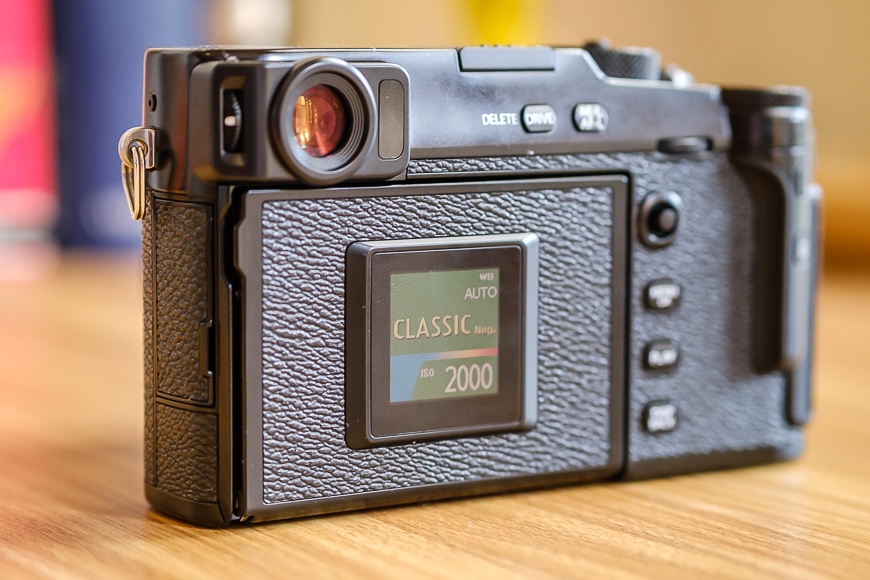
The sub monitor displays a classic mode with film stock artwork and a standard mode with camera settings.
In celebrating the retro qualities of this camera as well as Fujifilm’s extensive history with actual film, the X-Pro 3 features a sub monitor.
When the main LCD is closed there is a small 1.28-inch square colour memory LCD. This second monitor is not backlit so in low light, it can be hard to read.
The retro call back to film photography sees this sub monitor display the colour box art of the actual film simulation. It also shows White Balance and ISO much like a roll of film would have on the box.
In film photography days, once you loaded your roll of film, you would tear off the end of the box and slide it into a frame on the back of the camera. This way you would always remember what film and ISO you were shooting with.
The small monitor can also be set to a Standard Mode that shows you core camera settings such as Shutter Speed, ISO, Aperture, Exposure Compensation and Film Sims.
A similar sub monitor appeared on the Fujifilm X-H1 however it was a monochrome monitor whereas this one is full colour.
Further to this, the standard settings can be customised for both still and video settings.
The hidden LCD on the Fujfilm X-Pro 3, together with the retro-themed sub monitor to show your film simulation, encourages photographers to focus only on the shooting experience.
With the base information displayed on the sub monitor and the use of the function dials, you really do focus more on your composition than your camera output.
-
Electronic Viewfinder

The viewfinder on the Fujifilm X-Pro 3 provides ample magnification and clarity.
Another unique feature of the Fuji is that it sports a Hybrid Viewfinder that can change from a traditional Optical Viewfinder (OVF) to and Electronic Viewfinder (EVF) with the flick of a toggle located on the front of the camera.
Further to this, there is also a setting that allows you to have the OVF as your main view with a small EVF that appears in the bottom right corner.
The Optical Viewfinder has a great clear view with key information projected onto the screen. Exposure, Shutter Speed, ISO and other key details appear faintly and the information can be changed to a larger size for easier viewing.
Keep in mind that this is a rangefinder-style camera and when looking through the OVF you’re seeing the real world including the lens jutting out into your view.

The Fujifilm X-Pro 3 sports a Hybrid Optical and Electronic Viewfinder.
The screen is a Reverse Galilean viewfinder with electronic bright frame display that covers approximately 95% of the capture area. The OVF also has an x0.52 magnification.
The EVF is an 0.5 inch OLED colour screen with approximately 3.69 million dots and a 100% coverage area. The EVF has a magnification of 0.66× with a 50mm lens (35mm equivalent).
The whole EVF / OVF unit on the X-Pro 3 also features a sensor that knows when the camera is held up to your eye. This is especially beneficial when you want the camera to save power as the EVF/OVF turns off when away from your eye.
As for the smaller hybrid screen, this can only be used in OVF mode and will provide a digital representation almost like a picture in picture.
This little screen can also be used for focus checking as you can digitally zoom in on your subject and check for sharpness.
Ergonomics & Handling

All control dials and buttons are easily recognisable and accessible on the X-Pro 3.
Starting with the X-Pro 3 menu, Fujifilm is well known for its uncomplicated and easy to navigate menu system.
The main menu is broken down into six common sense sub-menus including Image Quality Setting, AF/MF Setting, Shooting Setting, Flash Setting, Movie Setting and Set Up.
Added to that there is an MY menu setting for your customised shooting modes.
Menu navigation is handled by the Menu/OK and the Disp/Back buttons on the rear of the camera body. In this model, Fuji has decided to remove the traditional D-pad in favour of the small joy-stick.
You navigate through the menu branches with ease thanks to the toggle or joy-stick on the back of the body.
The D-Pad that existed on previous Fuji cameras was fully customisable and each direction could be allocated to activating a function such as Film Simulation, White Balance and so on.
In place of this, the touch screen can be customised to recognise intentional swipes either up and down or left and right. These swipes can be assigned to various functions and, for the most part, are pretty accurate although not my preferred method.
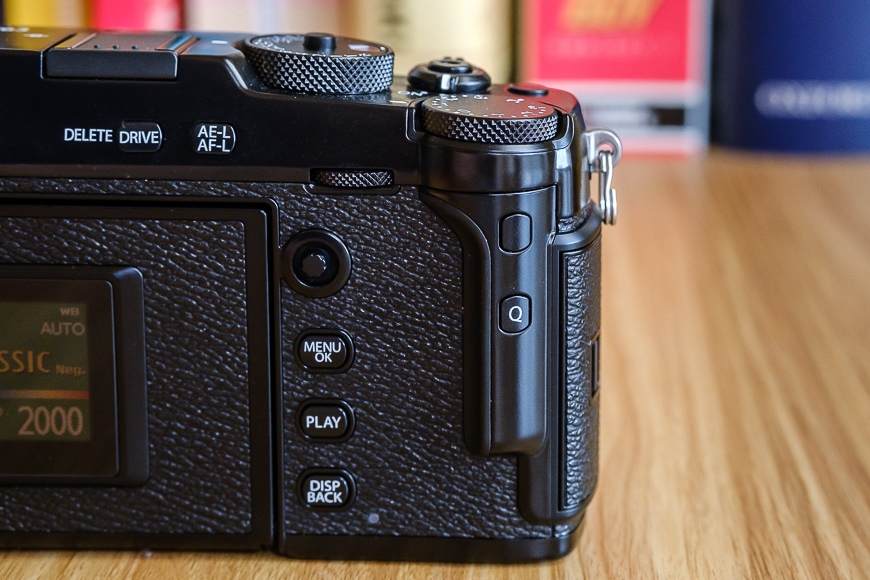
The button layout on the rear of the Fujifilm X-Pro 3 gives way for a decent thumb rest.
As with all Fujifilm cameras, the buttons and command dials are customisable and this gives you a great deal of freedom to set up the camera how you prefer it.
The design also has two unmarked function buttons that you can assign to a large number of functions. Further to this, there is a customisable front and rear command dial within reach of your thumb and forefinger.
With the removal of the D-Pad and the placement of the minimal number of buttons, there is a huge amount of thumb real estate to grip the camera with.
On the far edge of the rear of the X-Pro 3, the shape of the Exposure Compensation dial continues downward and creates a natural edge for your thumb to push against comfortably.
The front of the camera has a soft rubber grip and together with the thumb rest provides an assured level of control. All command dials and function buttons are easily within reach of the right hand and include an Exposure Compensation dial as well as a joint ISO Dial and Shutter Speed Dial.
To change ISO, you pull up the outer barrel of the ring and turn to adjust the setting while the Shutter Speed remains still. Once you have dropped this outer ring you can then change the shutter speed.
For me, this feature is a little tricky and it’s easy to accidentally move the Shutter Speed if you don’t pull up far enough on the ring. Thankfully, you can overcome this by setting one of the spare command dials to control ISO separately.
The Fuji X-Pro 3 provides you with complete control of your camera with access to core command dials with the right hand while the left controls the aperture and focus on the lens.
This is what Fujifilm is striving for with a camera like this and other flagship models. They’re trying to bring back the simple joy of photography with old school styling and sensible decisions on function control.
Focus Performance
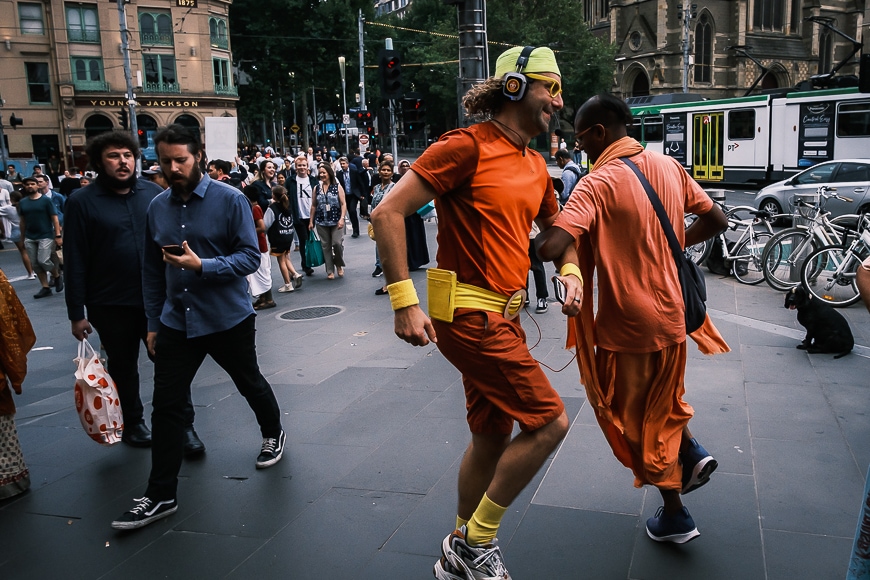
The X-Pro 3 came in handy when the Orange People clashed with the Mobile Silent Disco. Fujifilm X-Pro 3 + XF 16mm f/2.8 | 1/1000 f/5.6 ISO 800
The X-Pro 3 features the new X-Processor 4 and this represents the latest and greatest of Fujifilm technology.
As a result, the camera has been finely tuned to maximise the use of this chip along with the new 26.3-megapixel X-Trans sensor. Together the autofocus is incredibly fast and able to grab onto a subject with clear sharpness.
Moving subjects can be easily tracked thanks to the enhanced face and eye detect. Even when tracking a moving subject with dynamic movement the focusing system is able to hook on to the eye and maintain focus throughout.
Combined with the amazing 11 frames per second (fps) in continuous shooting, you’re able to capture your subject in full motion and still produce crisp images.

The X-Pro 3 is ideal for candid and street photography work. Fujifilm X-Pro 3 + XF 16mm f/2.8 | 1/1000 f/5.6 ISO 800
Of course, a major component of focusing speed is the ability of the attached lens to perform in unison with the camera. When shooting with the Fujifilm XF 16mm f2.8, I was able to attain fast and assured focus on my subjects and freeze them in time.
I also found that the camera performed just as well in low light and this is especially pleasing given the f/2.8 aperture of my lens.
Personally, I don’t like using a touch screen to fix my focal point as it feels counter-intuitive to me to hold the camera away from my eye.
Thankfully, you can turn this feature off so you don’t accidentally choose a focal point with your cheek. However, it’s completely possible and effective to use the touch screen to select a focus point, trigger the shutter on the chosen focal point or focus and shoot with the one-touch.
Another neat touch with the Fuji X-Pro 3 that will really suit street shooters is the Auto Focus Range Limiter. This function has two presets where you can limit autofocus from 2 meters to infinity or 5 meters to infinity.
What’s handy is that it also allows for a custom setting of any distance you like.
Low Light Performance

Even in low light the Fujifilm X-Pro 3 delivers crisp and well-rendered images. Fujifilm X-Pro 3 + XF 16mm f/2.8 | 1/125 f/2.8 ISO 2,000
It can easily be said that in this latest X-Pro 3 model, low light performance is brilliant.
Of course, a key element of low-light performance for the purposes of focus is dependent on the lens.
Regardless, thanks to the Intelligent Hybrid AF that utilises TTL contrast AF and TTL phase-detection AF, low light performance is effectively managed.
Further to this, the camera has an ISO range of ISO160~12800 (1/3 step) standard output and ISO80 / 100 / 125 / 25600 / 51200 extended output.
Image Quality

The Fujifilm X-Pro 3 is the ideal street photography camera. Fujifilm X-Pro 3 + XF 16mm f/2.8 | 1/1250 f/2.8 ISO 800
Fujifilm have often been applauded for the quality of their straight out of camera JPEGs.
In fact, many Fujifilm shooters will only shoot in JPEG with some in-camera adjustment to grain, shadow and sharpness as well as the application of their film simulations.
If you want to trust the capability of the X-Pro 3 along with your photographic skills, then you can really minimise your end-to-end workflow and still produce exceptional images straight out of the camera.
Of course, you can shoot in RAW format and produce exceptionally detailed and workable files ready for whatever level of post-production editing you desire.
Thanks to the option of either RAW Uncompressed or RAW Lossless Compressed, you can effectively manage your file sizes without losing quality.

The X-Pro 3 delivers crisp and sharp images. Fujifilm X-Pro 3 + XF 16mm f/2.8 | 1/125 f/5 ISO 1600
Another new feature of Fujifilm is the improvement of the HDR function found under the Drive menu.
The HDR has the standard HDR AUTO setting with increments up to HDR800. Further to this, Fuji has introduced HDR PLUS which allows the camera to take several images at set exposures and then stack them in-camera.
This level of computational image stacking is amazing, as is all of the in-camera editing that can be achieved. Regardless, this camera delivers exceptional images that are on par with those produced by the Fuji X-T3.
Film Simulations

The new film simulation Classic Negative has amazing colour values. Fujifilm X-Pro 3 + XF 16mm f/2.8 | 1/500 f/8 ISO 400
Fujifilm has a very long history of developing and mastering the colour science of film and then digital photography. They’re recognised as being the industry leader in this area and as such, they’ve invested considerably into replicating film stock in their digital camera range.
Fujifilm have always included Film Sims in their X-Series cameras and the Fuji X-Pro 3 is no exception.
Being the lastest and greatest of all that Fujifilm has to offer, the camera comes packed with 17 unique film simulations.
These allow photographers to develop high-quality JPEG images with film simulations and other minor edits actioned in camera.
Further to this, those that shoot in RAW can apply the film sims later in post-production depending on their editing software.

The film simulation Acros is based on Fujifilm 35mm film stock. Fujifilm X-Pro 3 + XF 16mm f/2.8 | 1/1000 f/5.6 ISO 800
Speaking of the latest, the X-Pro 3 is the first Fuji to feature the new Classic Negative simulation. This is very similar to the long-standing Classic Chrome simulation however is softer and less contrasty.
It applies an incredible old colour film to your images without any major editing at all. Classic Negative is already a popular application for many street shooters and others are calling for it to be applied via firmware to other Fuji cameras.
Shooting Experience
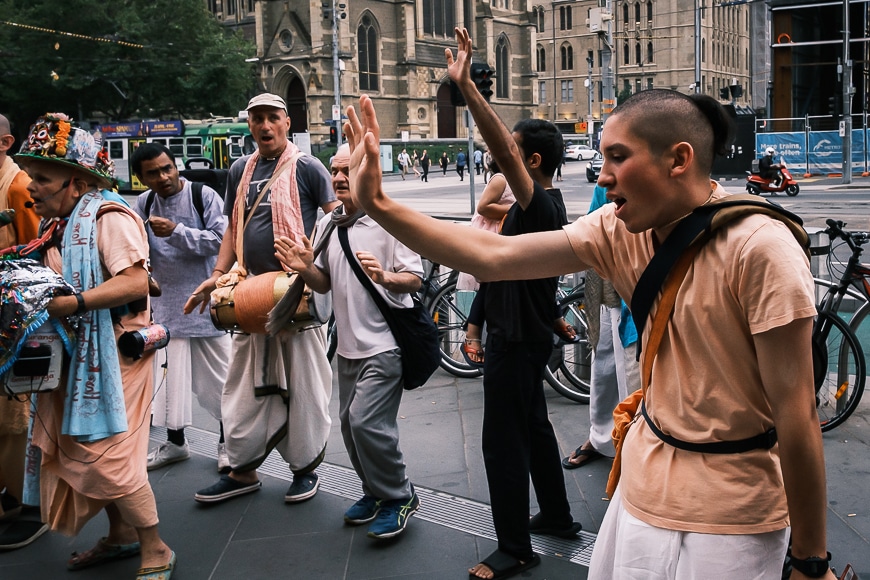
The X-Pro 3 delivers excellent image quality. Fujifilm X-Pro 3 + XF 16mm f/2.8 | 1/1000 f/6 ISO 800
The X-Pro 3 is an incredibly responsive camera that is quick to start up and ready to get into the action. The initial desire is there to check your rear screen to ensure you have everything ready.
While you can still do that, after time it becomes second nature to not do so and rely on your visible ISO, Shutter Speed, Exposure Compensation and Aperture dials. Also, a quick glance at the sub monitor at the rear of the camera shows your most essential information if in standard mode.
The camera has a high shutter speed of 1/8000 when using the mechanical shutter. If you jump over to the electronic shutter then you can amp that up to 1/32,000
When it comes to continuous shooting, the camera does not have a High and Low setting, unlike previous models. Instead, there is the option to set how many frames per second (fps) you wish to shoot at.
With the mechanical shutter, you can shoot at 11fps in RAW and can lower this down to 3fps if desired. At 11fps, the buffer has a respectable amount of capacity and can last for quite a good burst.
At 3fps, the buffer doesn’t even seem to notice until you cease shooting and it takes a moment to write to the memory card. Thankfully, this flagship Fuji features dual UHS-II card slots making high speed or continuous shooting even more reliable.
In terms of video capabilities, the X-Pro 3 is able to record DCI 4K(4096×2160) @ 29.97p for up to approx. 15 minutes. While this model has not been promoted as a champion of video, it’s nice to know that the capability is there should you ever need it.
It’s important to note that the camera does not feature an HDMI port but does have a USB-C slot and a 2.5mm MIC jack that would need to be expanded to 3.5mm via a connector.
A final feature worth pointing out is that this camera features both Bluetooth and Wifi that allows you to connect to the Fujifilm Remote Camera App on your smartphone. With this app, you can complete firmware updates, activate shutter release, transfer JPEG images to your smartphone and more.
Value for Money
Have no doubt that the X-Pro 3 is a premium product from Fuji and now stands shoulder-to-shoulder with its other flagship camera, the X-T3. Premium design, materials and manufacturing combined with performance and output always come at a price.
The standard black body that I’ve featured in this review retails for around $1,800 USD. That compares to an X-T3 that currently retails for around $1,250, however it’s worth noting that they have come down in price recently due to the upcoming X-T4.
If you want either of the bodies with the Duratech coating, the Dura-Silver or the Dura-black, then they retail for around $2,000 apiece. That’s correct, there’s a $200 increase for the scratch-proof Duratech coating.
When compared with other premium mirrorless camera brands, the price is actually quite comparable if not less expensive overall.
As mentioned, a premium product such as the Fuji X-Pro warrants a price to enable Fuji to deliver an exceptional camera that would suit anyone in any genre.
This camera is packed with the most up-to-date tech from Fujifilm and stands as a potential classic in the photography world.
Fujifilm X-Pro 3 Review | Conclusion

The X-Pro3 delivers crisp and sharp images. Fujifilm X-Pro 3 + XF 16mm f/2.8 | 1/400 f/5 ISO 400
Street photographers rejoice as this is the latest and greatest Fujifilm camera intended for you to pursue and enjoy your craft.
Even if street photography is not your thing, this camera can deliver in any field you test it in.
It truly is a remarkable product and one that sets Fuji apart from its direct competitors.
As mentioned earlier, Fuji is on fire at the moment with a number of cameras being announced within a few months. The X-Pro 3 represents the latest technology, design and thinking from this long-standing imaging giant.
They have harnessed all of their decades of history in colour science, film stock and of course digital technology. With this culmination of time and knowledge, they have developed a camera that is incredibly impressive to shoot with.
Further to this, it produces amazing images that stand out thanks to their sharpness, rendering and application of colour.
The X-Pro 3 provides photographers with old school simplicity as a result of its optical viewfinder, a full set of control dials and the hidden LCD. With this kind of interaction, your focus is placed squarely on the photographic experience rather than pixel-peeping for satisfaction.
Fuji’s intent with this product was to reinvigorate the joy of photography. I believe that they’ve succeeded in that vision and developed a body that could easily be mistaken for a film camera.
However, you still have full access to an incredibly intuitive menu system and set of functions and features to match any camera in the same market.
Whilst this camera comes at a higher cost than any other Fujifilm flagship body, you’re investing in a premium product that can easily provide you with a lifetime of photographic journeys and enjoyment.

Exceptional performance, titanium construction and a unique design make the X-Pro 3 stand out from the crowd.










